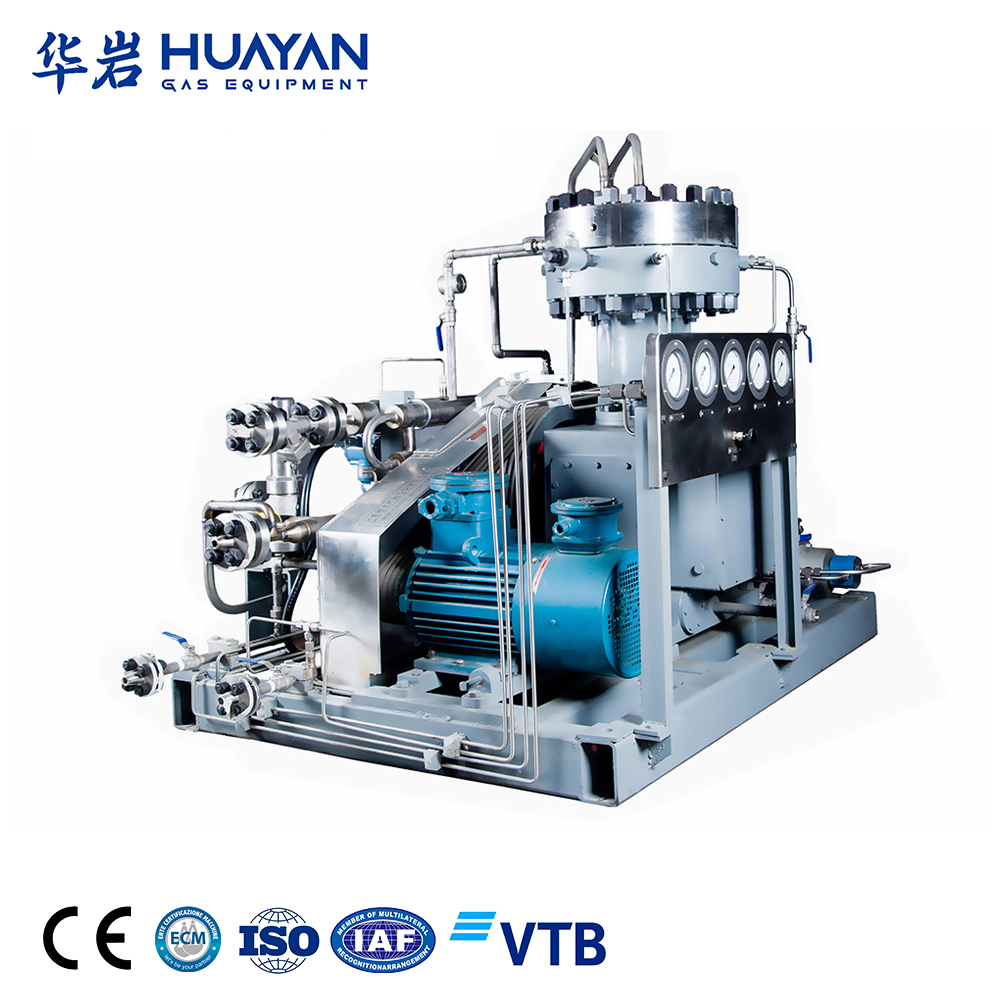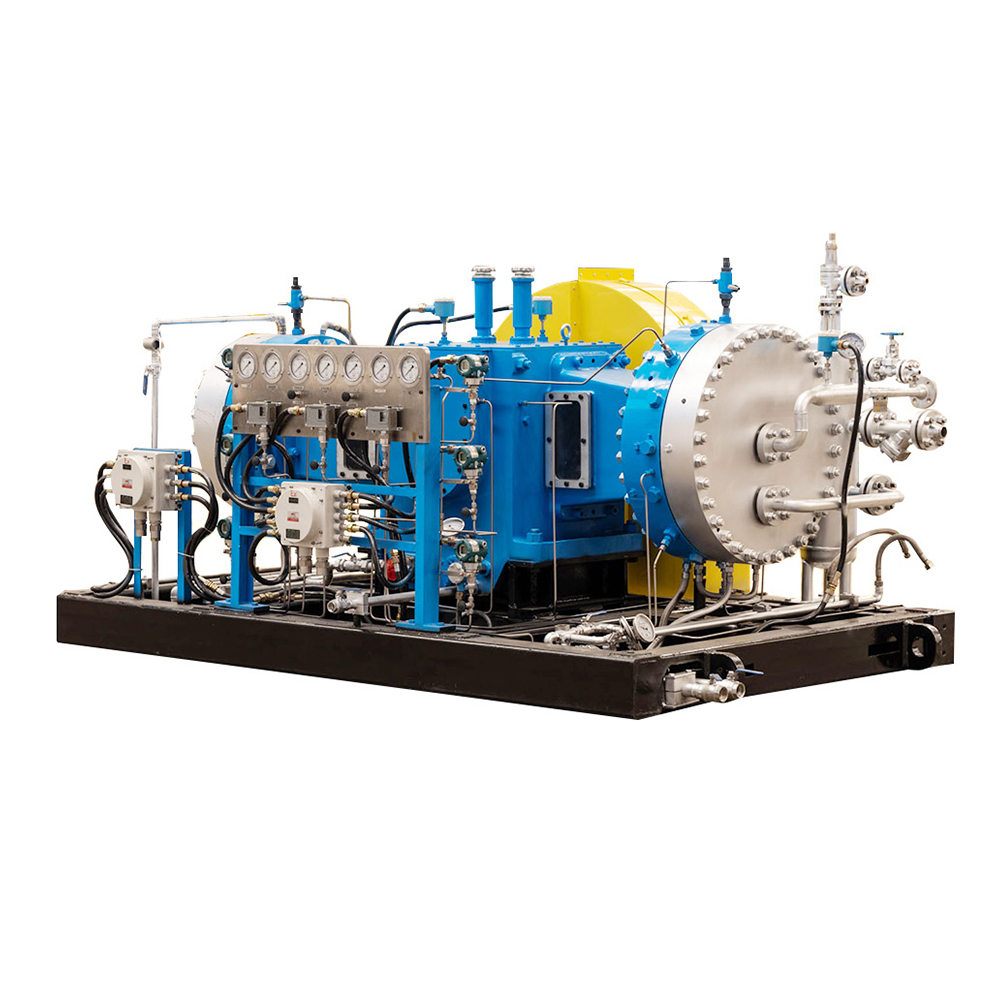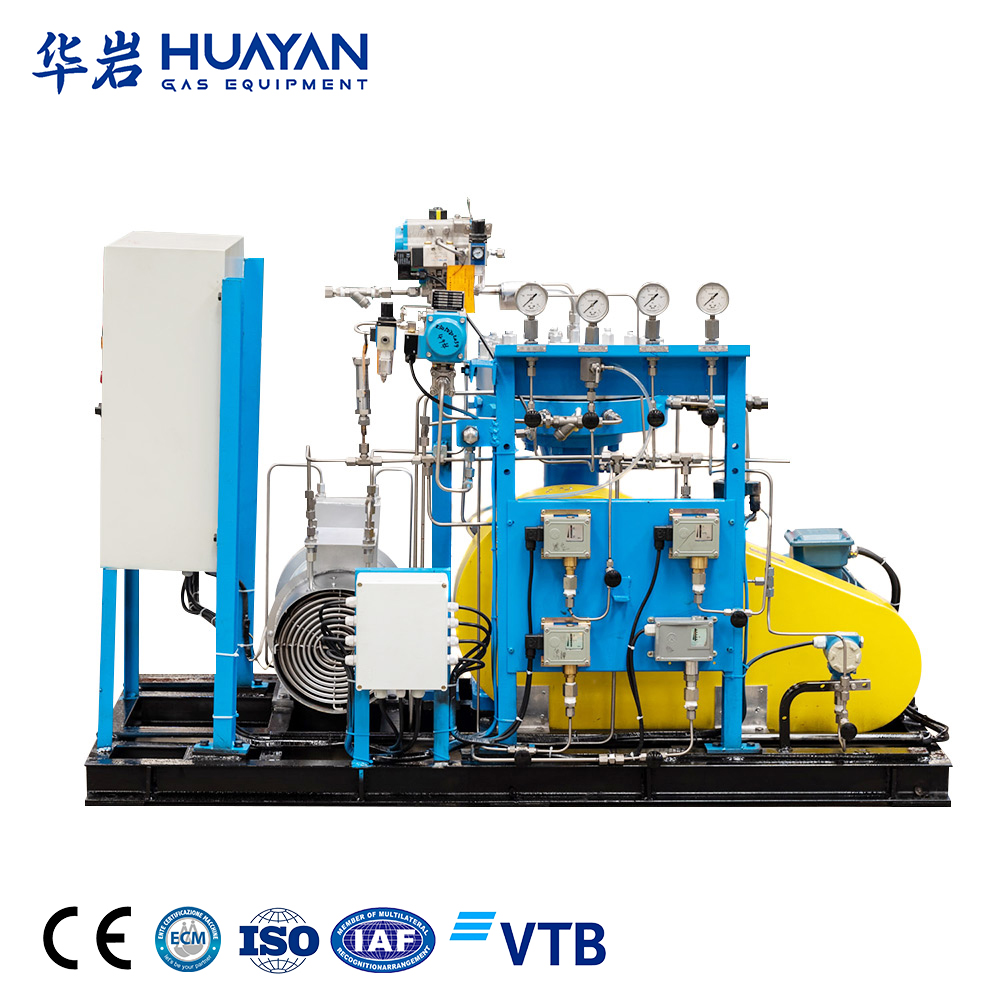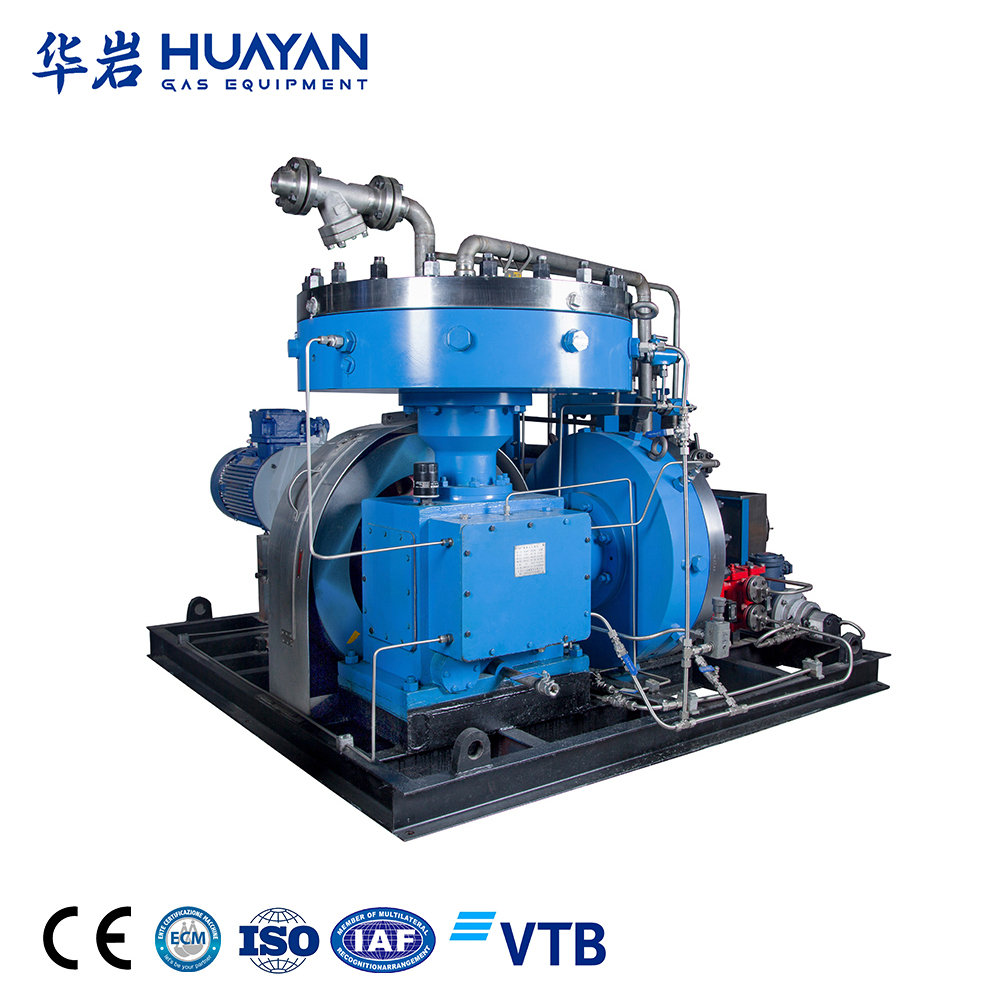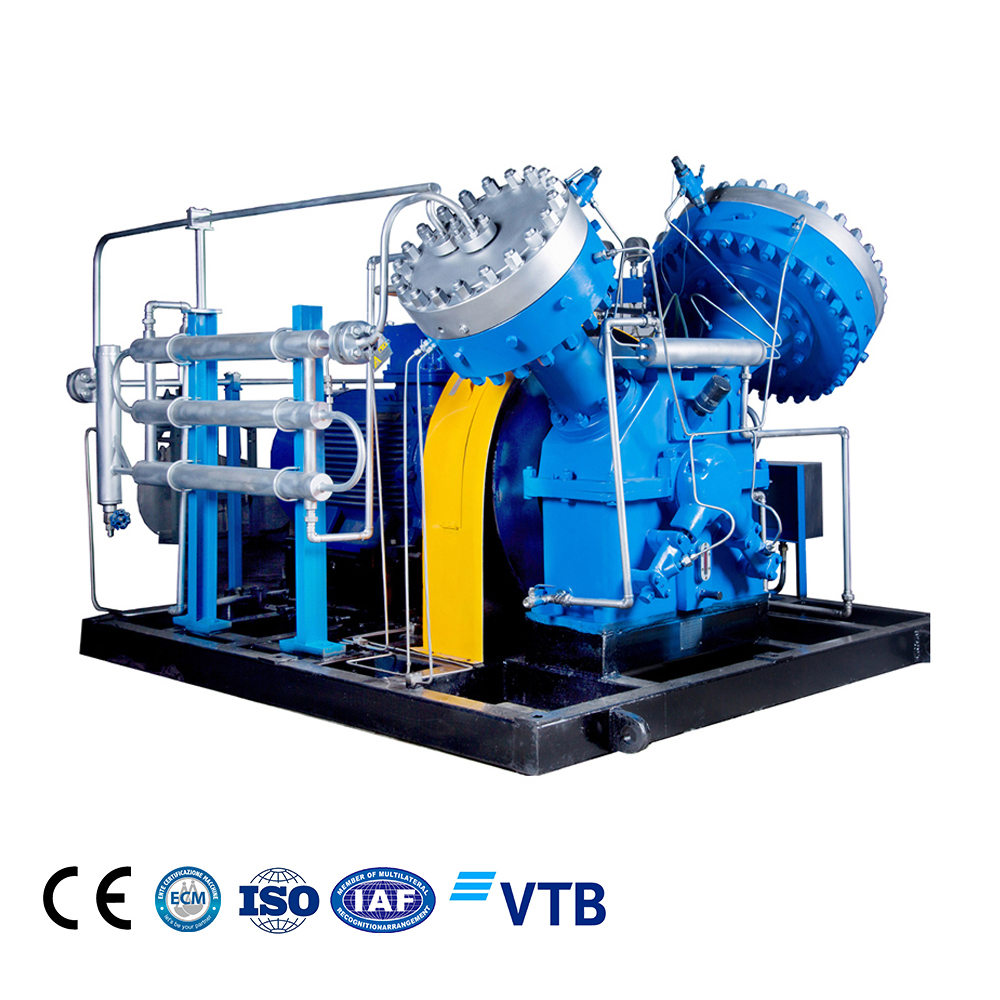
Carbon Dioxide Compressor
Home > Products > Diaphragm Compressor >
Carbon Dioxide Compressor
- Structural type: Vertical,V,horizontal type
- Suction suction pressure: 0~0.2MPa
- Discharge pressure: 0.3~3MPa
- Flow range: 150-5000NM/h
- Motor power: 22~400kw
- Cooling method: Air or water cooling
- Application: Widely used in food and pharmaceutical industry,refrigeration industry, petrochemical industry
Get Free Quote
Carbon Dioxide Compressor: Revolutionizing CO₂ Management
Introduction
The Carbon Dioxide Compressor is a sophisticated and indispensable device engineered to efficiently compress carbon dioxide gas. In a world where environmental concerns and industrial optimization are at the forefront, this compressor plays a pivotal role in various sectors, from enhancing energy efficiency to enabling sustainable practices.
Working Principle
At its core, the Carbon Dioxide Compressor operates on a fundamental principle. It draws in low-pressure carbon dioxide gas, typically sourced from industrial processes, power plants, or natural CO₂ reservoirs. Through mechanical means, such as reciprocating pistons, rotary screws, or centrifugal impellers, the gas is compressed. This compression process reduces the volume of the gas while significantly increasing its pressure. As the gas is compressed, it also heats up, which is managed through integrated cooling systems to maintain optimal operating conditions. The result is high-pressure carbon dioxide that can be effectively stored, transported, or utilized in a wide range of applications.
Types of Carbon Dioxide Compressors
Reciprocating Carbon Dioxide Compressors
Reciprocating compressors are known for their versatility and ability to handle high pressures. They use a piston and cylinder arrangement, where the piston moves back and forth within the cylinder. During the suction stroke, low-pressure CO₂ gas is drawn into the cylinder. As the piston moves forward in the compression stroke, the gas is compressed to the desired pressure. These compressors are often used in applications where precise pressure control and high compression ratios are required, such as in small to medium-scale industrial processes and some medical applications.
Rotary Screw Carbon Dioxide Compressors
Rotary screw compressors feature two intermeshing helical rotors. As the rotors turn, the space between them decreases, compressing the CO₂ gas that is trapped within. This type of compressor offers a continuous flow of compressed gas, making it suitable for applications that demand a steady supply of high-pressure carbon dioxide. Rotary screw compressors are commonly used in large industrial plants, carbon capture and storage facilities, and refrigeration systems due to their high efficiency and reliability.
Centrifugal Carbon Dioxide Compressors
Centrifugal compressors use a high-speed impeller to accelerate the CO₂ gas and convert its kinetic energy into pressure energy. The gas is drawn into the center of the impeller and then flung outwards by centrifugal force, passing through a diffuser where the velocity is converted into pressure. These compressors are ideal for high-flow applications and are often found in large-scale industrial operations, power generation plants, and large refrigeration systems.
Applications
Carbon Capture and Storage (CCS)
In the fight against climate change, Carbon Capture and Storage is a crucial strategy. Carbon Dioxide Compressors are integral to this process. They are used to compress the CO₂ captured from power plants and industrial emissions. Once compressed, the CO₂ can be transported via pipelines or tankers to storage sites, typically deep underground geological formations. This helps to reduce the amount of carbon dioxide released into the atmosphere, mitigating the impact of greenhouse gas emissions on the climate.
Industrial Processes
- Metal Manufacturing: In the metal industry, carbon dioxide is used in various ways. Compressed CO₂ is utilized in the production of casting molds to enhance their hardness and durability. It is also used as a shielding gas in welding processes, such as MIG/MAG welding, where it protects the weld area from atmospheric contamination, resulting in stronger and more reliable welds.
- Chemical Production: Many chemical reactions require carbon dioxide as a reactant or a processing agent. Compressed CO₂ is used in the production of chemicals such as urea, methanol, and carbonates. The high-pressure CO₂ can enhance reaction rates and yields, improving the efficiency of chemical manufacturing processes.
Food and Beverage Industry
- Beverage Carbonation: One of the most well-known applications of carbon dioxide is in the carbonation of beverages. Carbon Dioxide Compressors are used to pressurize CO₂ gas, which is then dissolved into beverages such as soft drinks, beer, and sparkling wines. This process gives the beverages their characteristic fizz and effervescence, enhancing the consumer experience.
- Food Preservation and Packaging: Compressed CO₂ is also used in food preservation. It can be used to create modified atmosphere packaging (MAP), where the oxygen in the packaging is replaced with CO₂. This helps to slow down the growth of bacteria, mold, and other spoilage organisms, extending the shelf life of food products.
Refrigeration and Air Conditioning
Carbon dioxide is emerging as a more environmentally friendly alternative to traditional refrigerants. Carbon Dioxide Compressors are used in refrigeration and air conditioning systems to compress the CO₂ refrigerant. In these systems, the compressed CO₂ is cooled and condensed, and then expanded to absorb heat from the surrounding environment, providing cooling. This technology is particularly useful in industrial refrigeration applications, such as cold storage facilities and food processing plants, as well as in some automotive air conditioning systems.
Advantages
Energy Efficiency
Our Carbon Dioxide Compressors are designed with energy efficiency in mind. Advanced engineering and innovative technologies are employed to minimize energy consumption during the compression process. This not only reduces operating costs for businesses but also contributes to a more sustainable and environmentally friendly operation. With high compression ratios and optimized cooling systems, our compressors can achieve maximum efficiency, ensuring that the energy input is effectively converted into high-pressure carbon dioxide output.
High Purity Output
We understand the importance of high-purity carbon dioxide in many applications. Our compressors are engineered to deliver compressed CO₂ with exceptional purity. This is crucial in industries such as food and beverage, where any impurities in the carbon dioxide could affect the quality and safety of the products. In medical applications, high-purity CO₂ is essential for accurate and reliable medical procedures. Through rigorous quality control measures and advanced filtration systems, our compressors ensure that the output carbon dioxide meets the highest purity standards.
Reliability and Durability
Built with robust materials and precision-engineered components, our Carbon Dioxide Compressors are designed to withstand the demands of continuous operation. Whether in harsh industrial environments or critical medical facilities, these compressors offer reliable performance day in and day out. The advanced design and construction minimize wear and tear, reducing the need for frequent maintenance and repairs. This results in increased uptime, lower maintenance costs, and a longer lifespan for the compressor, providing businesses with a cost-effective and dependable solution for their carbon dioxide compression needs.
Environmental Friendliness
Using carbon dioxide as a refrigerant or in carbon capture and storage applications is an environmentally friendly choice, and our compressors play a key role in enabling these sustainable practices. By facilitating the efficient use and management of carbon dioxide, our compressors help to reduce the reliance on traditional, more harmful refrigerants and contribute to the reduction of greenhouse gas emissions. In addition, the energy-efficient design of our compressors further minimizes the environmental impact, making them an ideal choice for businesses looking to reduce their carbon footprint.
Safety and Maintenance
Safety Features
- Overpressure Protection: To prevent any potential hazards associated with overpressure, our Carbon Dioxide Compressors are equipped with state-of-the-art overpressure protection systems. These systems are designed to automatically detect and respond to any abnormal increase in pressure. In the event that the pressure within the compressor exceeds the safe operating limits, the overpressure protection system will activate, releasing the excess pressure and preventing any damage to the compressor or potential safety risks to operators.
- Fire-Resistant Materials: The compressors are constructed using high-quality fire-resistant materials. This is of utmost importance when dealing with carbon dioxide, as it is a non-flammable gas, but in certain situations, such as in the presence of high temperatures or electrical malfunctions, fire safety is crucial. The use of fire-resistant materials minimizes the risk of fire spreading in case of an accident, providing an added layer of safety for both the equipment and the surrounding area.
- Leak Detection: Our compressors are equipped with advanced leak detection mechanisms. These systems continuously monitor the integrity of the compressor’s gas pathways, detecting any signs of carbon dioxide leaks. In the event of a leak, the system will immediately alert operators, allowing for prompt action to be taken. Early detection of leaks not only helps to prevent the loss of valuable carbon dioxide but also ensures the safety of the working environment by minimizing the exposure to potentially harmful gas concentrations.
Maintenance Requirements
- Regular Inspections: To ensure optimal performance and longevity, regular inspections of the Carbon Dioxide Compressor are highly recommended. These inspections should be carried out by trained technicians who are familiar with the specific requirements of the compressor. During the inspection, various components of the compressor, such as the pistons, rotors, valves, and seals, will be checked for signs of wear, damage, or malfunction. Any issues detected during the inspection can be addressed promptly, preventing more serious problems from developing and ensuring the continued reliable operation of the compressor.
- Filter Replacement: The air and gas filters in the compressor play a crucial role in maintaining the purity of the carbon dioxide being compressed. Over time, these filters can become clogged with dust, dirt, and other contaminants, reducing their effectiveness. To ensure the proper functioning of the compressor and the quality of the compressed CO₂, the filters need to be replaced at regular intervals. The frequency of filter replacement will depend on the operating environment and the level of contamination. We provide detailed guidelines on filter replacement intervals for each compressor model, making it easy for operators to keep their compressors in top condition.
- Lubrication: Proper lubrication of the moving parts in the compressor is essential for smooth operation and to reduce wear and tear. Our compressors are designed to be easily lubricated, and we provide clear instructions on the type of lubricant to use and the recommended lubrication intervals. Regular lubrication helps to ensure that the pistons, rotors, and other moving components operate efficiently, minimizing friction and extending the lifespan of the compressor. By following the lubrication schedule, operators can significantly reduce the risk of mechanical failures and costly repairs.
Choosing the Right Carbon Dioxide Compressor
When selecting a Carbon Dioxide Compressor for your specific needs, several factors should be carefully considered:
Application Requirements
The first step in choosing the right compressor is to clearly define the requirements of your application. Consider factors such as the required flow rate of carbon dioxide, the desired discharge pressure, and the purity level of the compressed gas. Different applications, such as carbon capture, industrial processes, food and beverage carbonation, or refrigeration, have specific requirements for these parameters. By understanding your application’s needs, you can narrow down the selection of compressors that are suitable for your use.
Space and Installation
Take into account the available space for installing the compressor. Compressors come in various sizes, and you need to ensure that the chosen model will fit comfortably in the designated area. Additionally, consider the installation requirements, such as the need for proper ventilation, access for maintenance, and connection to other equipment in the system. Some compressors may require a specific mounting configuration or additional support structures, so it’s important to plan for these aspects in advance.
Budget
Set a realistic budget for your compressor purchase. Consider not only the initial cost of the compressor but also the long-term operating and maintenance costs. Energy-efficient compressors may have a higher upfront cost but can save you significant amounts of money in the long run through reduced energy consumption. Also, factor in the cost of spare parts, maintenance services, and any potential upgrades or modifications that may be required over time. By evaluating the total cost of ownership, you can make a more informed decision that aligns with your financial goals.
Reliability and Reputation
Choose a compressor from a reputable manufacturer with a proven track record of reliability. Research the manufacturer’s reputation in the industry, read customer reviews and testimonials, and inquire about their after-sales support services. A reliable compressor will minimize downtime, reduce the risk of production disruptions, and provide you with peace of mind. A manufacturer that is known for its quality products and excellent customer service is more likely to stand behind their compressors and offer prompt assistance in case of any issues.
In conclusion, the Carbon Dioxide Compressor is a versatile and essential device that plays a vital role in multiple industries. Its ability to efficiently compress carbon dioxide gas enables a wide range of applications, from environmental protection to industrial optimization and consumer product enhancement. With our high-quality compressors, featuring advanced technology, energy efficiency, reliability, and a focus on safety and maintenance, you can find the perfect solution for your carbon dioxide compression needs. Explore our range of Carbon Dioxide Compressors today and take the first step towards more efficient and sustainable operations.
Carbon Dioxide Compressor Parameters
| S/N | Model | motor power(kW) |
inlet pressure (Mpa) |
outlet pressure (MPa) |
Flow (Nm/h) |
| 1 | ZW-3/2-3 | 11 | 0.2 | 0.3 | 480 |
| 2 | ZW-5.5/2-6 | 45 | 0.2 | 0.6 | 900 |
| 3 | ZW-2/20 | 22 | atm | 2 | 110 |
| 4 | VW-3/20 | 37 | atm | 2 | 165 |
| 5 | VW-4/20 | 45 | atm | 2 | 220 |
| 6 | VW-5/20 | 55 | atm | 2 | 285 |
| 7 | VW-6/20 | 75 | atm | 2 | 330 |
| 8 | VW-6.8/30 | 75 | atm | 3 | 370 |
| 9 | VW-8/20 | 90 | atm | 2 | 570 |
| 10 | VW-12.5/25 | 132 | atm | 2.5 | 750 |
| 11 | VW-22.5/8 | 160 | atm | 0.8 | 1200 |
| 12 | VW-45/8 | 280 | atm | 0.8 | 2400 |
| 13 | VW-22.5/22 | 200 | atm | 2.2 | 1200 |
| 14 | VW-28/22 | 250 | atm | 2.2 | 1550 |
| 15 | VW-36/12 | 315 | atm | 1.2 | 2000 |
| 16 | VW-45/22 | 400 | atm | 2.2 | 2500 |
| 17 | DW-32/0.05-3 | 132 | 0.05 | 0.3 | 1800 |
| 18 | DW-30/2-8 | 280 | 0.2 | 0.8 | 4900 |
